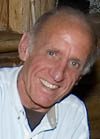Life near hole 18
- 2010 on Jul 07
- in Planet Patagonia
- No Comments »
There is something to living at a golf course, even if one can’t tell a number 2 from a number 7 iron and wouldn’t know how to hit the ball off a tee with either one.
Above all it’s the scenery. The carefully designed and ‘built’ landscape around the eighteen holes with their greens, ponds and bunkers resembles an expansive park which constantly invites one to a leisurely stroll.
Discovering small, surprising details, like a fairway mirrored in the pond or the shadow from a row of pine trees cast across a green, makes one appreciate the creative thought that went into the layout.
In the case of the golf course here, at the entrance to the San Martin valley, there’s also the location in the hilly terrain at the foot of Chapelco Mountain, (from which the “Chapelco Golf & Resort” borrowed his name) which in itself is enough to create an almost magical atmosphere. From ‘my’ house up on the flank of the hill on the eastern boundary of the site I have a superb view, which, especially during the evening hours, is the best tele-vision show on any channel.
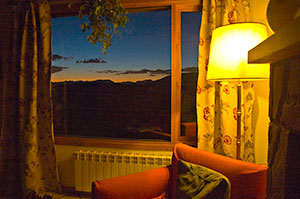
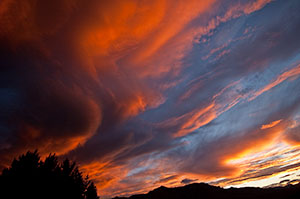
Secondly, there is a clubhouse. From its big saloon it affords superb views of lanes one, nine and eighteen with the mountains as backdrop. At close range one can watch the minors take their first swings on a little green serving as a kindergarten, while the majors battle it out between the hazards.
And, of course, there is the food! This is a perfect place to get eyes and palate satisfied simultaneously. From the menu I conclude, that clubhouse and Hotel (five stars – argentinian stars, that is) collaborate closely in the gourmet department: food and drink is excellent! Despite the upper class ambiance prices are very modest, at least when compared to a typical Swiss country diner.
So, theoretically, between working (writing stories, articles and blog entries), relaxing and eating, there is not much incentive to leave the place.
In reality, things look different. A lot of those little errands which I usually (in Europe or the US) took care of online, via phone or email, require personal presence in Argentina. Paying a bill, any bill, means handing over the dinero to the guy at the bank, the lady in the office of the phone- or insurance company. And for that one has to go downtown. Which is about 10 miles away. No problem, if one has a car. Most of the vehicles I see driving around the course are compatible with the upscale environment. Large SUV’s, monster-pickup’s and every once in a while something more sportive, a souped up Honda or a spiffy Beamer, ‘spare’-mobils should the family car require maintenance.
With respect to the automotive segment I fit in nicely with my metallic blue ’94 Ford Explorer. I am lacking, however, the trendy rag top to cover my transportation needs when “Big Blue” calls a time-out to get an oil change or an alignment.
And it’s then, that there’s something else to living on a golf course: the challenge to get around without a car.
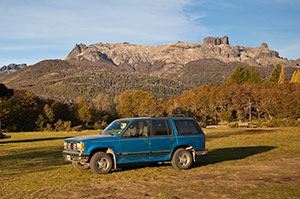
The first time I had to take my car to Jorge, the mecanico whose grandpa lived in a small village near Luzerne, Switzerland, was about a month ago. So I dropped Big Blue off and took the colectivo downtown, had a coffee at my favorite bookstore and then jumped om the bus to Junin, the next town about 30 miles east. I told the driver to add a stop enroute at the “golf” and from the entrance gate it was a 25 minute stroll to la casa mia.
Of course, it was the other direction, which posed the real challenge. There is no official bus stop at the turn-off to “Chapelco Golf&Resort”. And since it sits at a long straight section of Routa 234, where everybody goes at least 70 mph one last time before hitting the brakes for the first S-turn down into the valley, there’s little chance that anyone would see, much less stop for a lone hitchhiker.
So the options are to somehow flag down the bus from Junin or to call a cab from San Martin, a 12 buck one way extravaganza, which I wanted to safe for real emergencies. I walked to the gate to inquire. The girls told me, that the bus would be leaving Junin in about 10 minutes and take roughly 20 minutes to get here. Why don’t I sit down in their a/c-ed booth and listen to music on the internet while waiting. With five minutes until ETA (Expected Time of Arrival) of the bus I walked away from Salsa out into the sun.
After a short while an ancient Jeep – vintage late fifties, I’d guess – came out of the gate, pulled up and the driver motioned me to “embark”. The thing was painted in light blue – yes, painted, with paint runs and orange peel surface allover. Heavy shipyard-steel was welded in, where time and weather had eaten away the original parts. And, just like on a boat, there was a windscreen, but nothing one could describe as roof or cabin or doors. Only the rollbar made of heavy tubing didn’t seem to fit the rather maritime appearance.
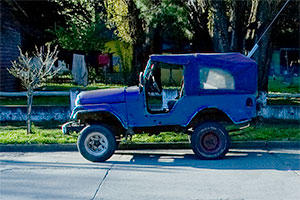
I parked my backpack on a roll of heavyduty steel rope and stowed my legs underneath two big loudspeakers dangling down on thin wiring from a steelplate serving as instrument panel and firewall. Then we got rolling. Up to about 30mph the Oldie accelerated rather smoothly, but then we seemed to hit something like the sound barrier. Our vehicle started to shake and rattle, vibrations ran through the chassis and I was glad I had a heavy bar right in front of me to hang on to and thus avoid going over board.
Obviously it wasn’t an atmospheric shockwave which agitated the poor Jepp to such a degree and the surface of the road had nothing to do with it either: only smooth asphalt. The way my driver clung onto the steering wheel and the cautious manner in which he lifted his foot from the accelerator pedal gave the clue: one of the wheels had started to run amok, due to an unfortunate resonance between spring forces in the suspension and the centrifugal forces on a rotating tire.
After a hundred yards, the front axle had hardly started to behave, I felt the faint pressure of acceleration on my back again. The needle of the speedometer, the only instrument in the panel, approached in erratic motion once more the dreaded 30mph mark. I realized: my fearless pilot went for a second attempt to find a hole in the barrier – and by sheer magic he found it. This time our topless racer slid without even the slightest shiver across the critical threshold and reached an amazing 47mph.
Everything was cool.
Almost everything.
My chauffeur still worked that steering wheel like in a frenzy but nothing much seemed to happen to the direction the Jeep was going. That steering must have had a play of at least half a turn! All the while he was whistling merrily – and now, as we approached the infamous S-turn, he began adjusting his New York Yankees baseball cap, with both hands, as if this thing was on full autopilot. With the confidence of a true master he negotiated the two curves at full speed but then our ride in the “zone” had to come to an end: road construction, one lane only, a big sign warned. On the washboard surface of a torn up section our mustang went into a full rodeo display. Mister New York Yankees fought and swore and almost ripped off that wheel, but we made it. He stopped in front of Jorge’s shop and I disembarked.
As I felt solid ground under my feet I thanked my stunt driver and wished him happy driving.
” Only to my mecanico” he answered and added with a grin ” no more jimmie “, imitating with his hands the wild gyrations of the unbalanced wheel.
Tags: in english
Comment? Antwort?

